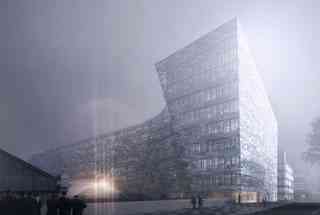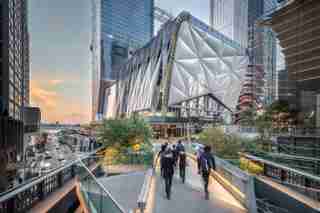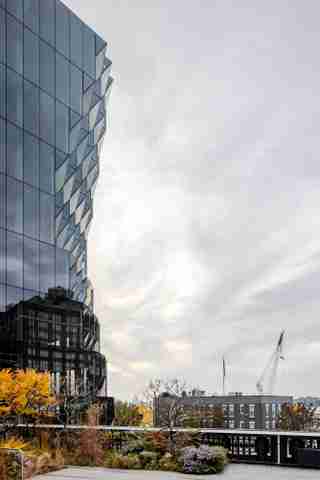September 05,2022
The 14 Most Anticipated Buildings of 2019
by David Stewart
As 2018 nears an end and one year folds into the next, we at Architectural Digest are looking ahead to highlight those buildings we’re most excited about for 2019. Spanning cities from Taipei to Miami, these soon-to-be completed structures will surely impress architecture lovers as well as those who casually stroll by.
2019 will see two buildings completed from the inimitable mind of the late Zaha Hadid. With her died one of the boldest visions of modern architecture in our history. There will come a time when Zaha's full vision will cease to be realized. Fortunately, 2019 is not one of those years.
By the end of 2019, iconic structures ranging from the Statue of Liberty in New York Harbor to the Pyramids of Giza in Egypt will both feature brand-new museums that will tell their remarkable story. And of course, the much-anticipated opening of the TWA Hotel will mean that Eero Saarinen’s famous 1962 design of the TWA Flight Center airline terminal will once more greet travelers from all corners of the globe.
Some of the buildings completed in 2019 will be loud, contorting their exteriors to ensure your attention is maintained, while others are decidedly more muted in their appearance. Bold or restrained, what is certain is that the act of writing about these buildings is difficult. In fact, taking a three-dimensional feat and transforming its essence onto a two-dimensional page leaves much to be desired. With that in mind, we urge you to use this list as a way to know where these spectacular structures reside, so that one day soon you can visit and experience them for yourselves. As the renowned architect Robert Venturi said in his book Complexity and Contradiction in Architecture (1966), architecture has the ability of allowing us to “see familiar things in an unfamiliar way.” We believe these 14 buildings do just that.

Le Monde Headquarters, by Snøhetta (Paris, France)
Founded in 1944, Le Monde is among the most widely read newspapers in the world. The publication has long strived to be better than all other news organizations. So why should its headquarters be any different? Next year, Le Monde will be moving into its brand-new home, a multimillion-dollar building that will look like a bridge—a subtle nod to bridging the gap between the publication and its readers. Designed by the Oslo-based firm Snøhetta, Le Monde ’s new headquarters will give a fresh, bold look to Paris’s skyline.

The Shed, by Diller Scofidio + Renfro in collaboration with Rockwell Group (New York, New York)
New Yorkers and tourists alike will inevitably scratch their heads when they first see The Shed, one of a bevy of new structures being completed in the all-new Hudson Yards project (the largest private real-estate development in U.S. history). Indeed, the 200,000 square-foot building, designed by Diller Scofidio + Renfro in collaboration with Rockwell Group will likely be the star in a dense field of buildings going up in the Midtown neighborhood. The structure has the ability to accommodate a wide range of performances (in fact, Björk is slated to perform there in 2019). Yet, this is no typical cultural venue. Far from it. See, the thing about this building is that it was designed to be amorphous. The outer shell is sitting on a set of wheels, which are connected to a short-length track. Once activated, the shell moves away from the main frame of the building, in effect, creating a whole new building that’s connected to the original one. All those who were scratching their heads upon first glance of The Shed will surely have dropped jaws once they see the building multiplying into two.

40 Tenth Avenue by Studio Gang (New York, New York)
By the end of 2019, visitors to New York’s Meatpacking District neighborhood will be greeted by an all-new modern office building. While the structure will surely stand out to its neighbors, the design will not be as easy to decipher. Inspired by the cosmos, Studio Gang angled the building based on the rays of the sun. Yet what makes this design so special, and so different from almost any other in the city, is that its shape was formed exclusively with the public in mind. To that end, Studio Gang carved away spaces of the building to allow ample amounts of sunlight to hit New York’s popular, much-traveled High Line park. While the public green space snakes right next to Studio Gang’s newest design, the quality of light and overall experience for its many visitors is not diminished—if anything, they're enhanced.
TWA Hotel by Beyer Blinder Belle (Flight Center Renovation) and Lubrano Ciavarra Architects (New York, New York)
In a word, Eero Saarinen’s landmark 1962 TWA Flight Center at JFK Airport was magic. For several years, Beyer Blinder Belle, Lubrano Ciavarra Architects, and MCR Development have busied themselves with the restoration of the space into a stunning hotel. Finally, this year marks the much-anticipated reopening of modernist architect Saarinen’s TWA Flight Center at John F. Kennedy Airport in New York City. The structure, which will include a complete refurbishment of the 1962 Saarinen terminal and its two airport tunnels, will feature two new-build hotel wings with 512 guest rooms that were designed by Stonehill Taylor. Anyone who loved the TV show Mad Men and dreams of living in a midcentury-modern world, this hotel is for you.
One Thousand Museum by Zaha Hadid Architects (Miami, Florida)
The building, like so many structures designed by the great dame, mimics the dynamic energy of the city in which it resides. When the luxury condominium skyscraper is completed in 2019, architecture fans will likely be both excited and melancholy. The enthusiasm will be for obvious reasons, while the subdued mood will be for the fact that the design was one of the final projects Hadid orchestrated before her death in March 2016. The 62-story, 699-foot-tall, 83-unit skyscraper has been one of the most ambitious architecture projects to date. So much so that PBS profiled the extreme difficulty in designing and constructing the skyscraper in its series Impossible Builds.
Statue of Liberty Museum by FXCollaborative Architects (New York, New York)
By May 2019, the Statue of Liberty in New York Harbor will have a new and permanent guest on her island. Aptly named the Statue of Liberty Museum, the $70 million structure will not only house the history of America’s most precious statue, but also the original, 3,600-pound torch that Bartholdi designed and placed on the statue in the late 19th century. Designed by the American architecture firm FXCollaborative, the 26,000‐square‐foot museum will house artifacts, original concepts for her design, and the ever-expanding need for liberty, giving greater understanding to the meaning of the massive statue which stands mere feet away. Yet it’s not just the interiors; the exterior is glad in cooper which, over time, will oxidize to match the same emerald green of the statue itself. The building all comes together with a green rooftop where visitors have uninterrupted views of the Statue of Liberty and beyond it, New York City. If the Statue of Liberty represents the American Dream, then the new museum is the home in which the history of that dream is showcased for the public.
Beijing Daxing International Airport by Zaha Hadid Architects (Beijing, China)
When Daxing International Airport is completed in the fall of 2019, Beijing will replace Istanbul as the city with the world's largest airport. Spanning some 7.5 million square feet and designed before the death of the inimitable architect Zaha Hadid, the airport will certainly usher in a new wave of major transportation design. Don’t let the beautiful, golden, starfish-shaped terminal from the renderings fool you into believing this building is merely design-focused, with no utilitarian cause. The structure, which is a web of concrete, rebar, and glass, will implement new innovations (like stacking international and domestic flights on different levels) to help passengers navigate the buildings more quickly and efficiently.
Norton Museum of Art by Foster + Partners (West Palm Beach, Florida)
Anyone who has visited the Norton Museum of Art in West Palm Beach, Florida, knows that the interiors featured some of the most recognizable collections of American, European, and Chinese masterpieces. The exterior, however, with its windowless frame, was another story. And one museum administrators were eager to rectify. In 2013, the museum unveiled a $100 million plan that was to be spearheaded by Norman Foster. Of course, the additions would mean more square footage of gallery space (nearly doubling the previous amount), adding an auditorium and restaurant. Yet unlike renovations that are a departure from the original plan, Foster’s design does quite the opposite. In fact, the new scheme brings back much of the original design that was created in the early 1940s by architect Marion Sims Wyeth. His structure was outfitted in an Art Deco–inspired building that revolved around a central courtyard. Once completed, the renovated building will feature a public sculpture park, Norman Foster’s first.
Pace Gallery Headquarters by Bonetti Kozerski Architecture (New York, New York)
In the heart of New York's art district, the Pace Gallery will open its new headquarters in 2019. Located in Chelsea, the eight-story structure will more than double the previous footprint. Indeed, with 75,000 square feet of space, art lovers will have ample opportunity to take in some of the best work the city has to offer. This experience will certainly be enhanced by the layout of the space, which came courtesy of the creative minds at Bonetti Kozerski Architecture. The column-free floors mean that visitors are free to view the art at any distance. What's more, the firm worked with lighting designer Arnold Chan to create a system where the lighting will adjust to fit the hue and/or mood of any given exhibition on view. Yet this building will not merely be enjoyed by those who walk inside it. The oversize windows adds a welcoming glow to the volcanic stone façade.
Academy Museum of Motion Pictures by Renzo Piano (Los Angeles, California)
It's fitting (and, frankly, seems overdue) that by the end of 2019, Los Angeles will be home to the world's premier movie museum. The space, which will be built within the Saban Building (formerly the May Company Building) on L.A.'s famed Miracle Mile, will provide visitors a quiet space to ponder and discuss the impact and role of film in our culture. Designed by Renzo Piano, and in collaboration with Gensler, the new museum will feature a 1,000-seat theater and terrace which will provide elevated views of Hollywood. Walking through the open, spherical structure will allow visitors views of their world they otherwise wouldn't be able to see. Which is to say, it's a similar vantage point to what movies provide their audiences.
Ruby City by Adjaye Associates (San Antonio, Texas)
Sir David Adjaye never ceases to amaze the world with his bold, impactful designs. And his vision of the Ruby City in San Antonio is certainly no exception. The building, which was aptly named for the popping façade, will be an all-new art center funded by the artist, collector, and philanthropist Linda Pace. The museum will house some 800 works of art in 14,000 square feet of space (including paintings, sculpture, and videos). The goal of the new museum was to kick-start San Antonio's art scene. And if the Ruby City is any indication of things to come, south central Texas has a bright future of cultural exploration.
Grand Egyptian Museum by Heneghan Peng Architects (Giza, Egypt)
The competition to design a museum for the pyramids in Giza was understandably competitive. It's not every day (or every lifetime, for that matter) that an architect is afforded the distinct opportunity to create a structure that will overlook and pay homage to one of the Seven Wonders of the World. After some 1,500 entries poured in from around the globe, the winning design was awarded to Heneghan Peng Architects. The Europe-based firm has won such impressive awards as the RIBA in 2006, while being nominated for the Stirling Prize as well as the Mies van der Rohe Award, both in 2013. Construction on the building has been lengthy (then Egyptian president Hosni Mubarak laid the foundation stone in 2002), but as the building nears completion, it looks like the wait was worthwhile. The building is made up of a series of triangle patterns intended to mimic the pyramids they are honoring. The massive, 5.2-million-square-foot structure (which reportedly cost over $1 billion to build) will house artifacts from the pyramids, while explaining their history. Most notable, however, will be the museum's presentation of King Tutankhamun's possessions.
Taipei Center for Popular Music by Reiser+Umemoto RUR Architecture DPC (Taipei, Taiwan)
When the Taiwanese government was searching for the right design for an all-new music center, they wanted the structure to be not only bold but instantly recognizable to crowds both domestic and international. After a competition ensued, they selected the New York–based firm Reiser+Umemoto RUR Architecture. The design—which features a geometrically complex building outfitted with a mix of arcs and fractal shards—is a clamlike structure that will house a 5,000 seat theater and a series of markets, cafés, and restaurants in the surrounding complex that will be open 24 hours, making the venue, much like Taiwan's pop music scene, an all-night affair. If nothing else, this building will prove to be a gem for anyone looking for fresh, Instagram-appropriate architecture shots.
National Museum of Qatar, by Jean Nouvel (Doha, Qatar)
Designed by the inimitable Jean Nouvel, the National Museum of Qatar looks as if it would better belong on another planet as opposed to a Qatari port city. Much like Nouvel's other world-class buildings, this structure offers the world something it's never seen before. Each part is connected to mimic a desert rose, while the interlocking disks are nearly the same beige as the surrounding desert. The space will house artifacts related to themes that have come to define the country: oil and gas, trade, and the Persian Gulf.






